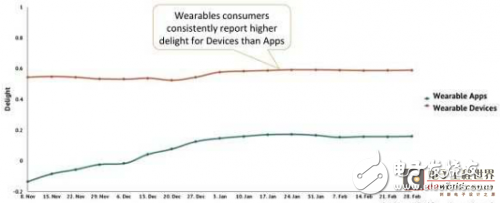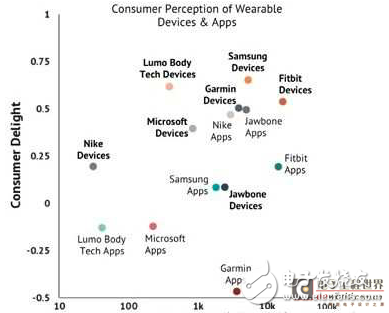Two pictures explain why wearables don’t fire
The wearable device market was initially said to be just a collection of unrealistic glasses and bulky wristbands that are rapidly evolving into a network of connected sensors. While fitness wristbands and smart watches are the foundation of the current wearables market, technology advances have allowed manufacturers to turn everything into wearable devices. With the improvement of hardware and the expansion from wrist to application, it is increasingly important to provide users with a comprehensive analysis of all personal data.
Market research firm Argus Insights conducted a survey on wearable devices and applications (APP) for 136,000 consumers from November 2015 to February 2016. The survey examines the naturally occurring "gap" between wearables and apps and its possible impact on the future of the market.

Satisfaction with wearable device apps is increasing, but consumers have a much higher preference for wearable devices
Argus Insights analyzed the existing wearable device App display, users are most frustrated in data synchronization, and the app experience is not good. When users try to use the App to track metrics such as calories, heart rate, steps, and sleep, they often have difficulty interpreting all of their personal data and cannot use it.
As hardware continues to evolve and gradually expand beyond the watch, users need a killer app to process and present the data from these wearable devices. In order to continuously enhance the user experience, the industry must integrate all the collected personal data in a simple and easy-to-understand way to encourage users to take concrete actions.
The result of one of the comparisons is more thought-provoking. Although consumers are satisfied with hardware products from brands such as Samsung, Lumo Bodytech and Fitbit, the apps that these brands offer for their products are also not popular with users. On the other hand, the research report shows that although consumers are not satisfied with their Jawbone device, they have the highest rating for the Jawbone App.

Consumer satisfaction with wearable devices and apps
In this market full of scattered data sets, users consistently give the Jawbone App a "great all in one app" rating. In addition to the purpose of a variety of health and fitness data sets, users also like to offer viable advice from the SmartCoach App.
Wearable devices are highly anticipated, and operators must try to keep the user fond of using them, otherwise the device will eventually become the fate of discarding the corners of the drawers. A good app has the magic to create a user's "sticky" experience, especially if the app can help users improve their daily lives based on data collected from different sensors.
The current app experience limits the usability of wearable products. Today's hardware and embedded sensors have been very useful in data collection, but without the ability to interpret the data to spur users' actual actions and promote change, these devices seem to become dispensable.
Wearable devices only show their usefulness when collecting data. At the same time, the amount of data can be quickly accumulated when various devices such as hats, pants, tattoos, socks, rings, etc., start collecting data. It's important to improve the hardware to collect data more efficiently, but the real value comes from the interpretation of the data and existing applications that don't provide a seamless experience for the user.
Household Electrical Appliances
gree , https://www.greegroups.com